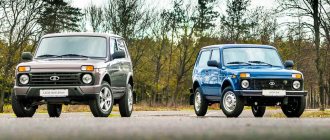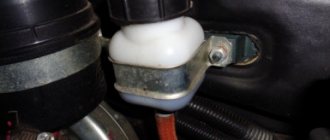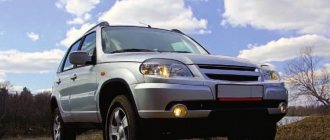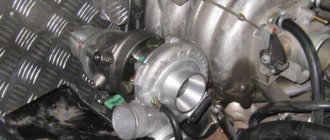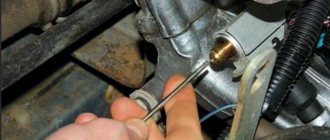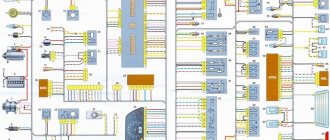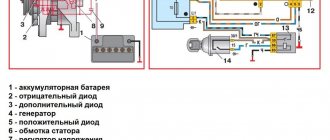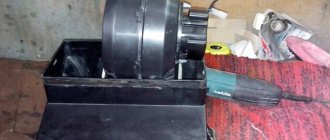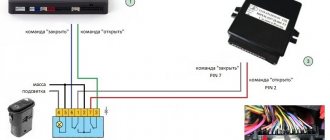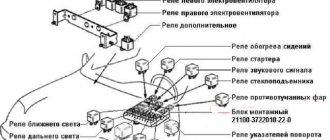What should you not do?
Many car owners and simply “garage experts” advise getting rid of the adsorber, supposedly this device increases fuel consumption. In fact, it cannot affect this parameter. In addition, the adsorber has a valve that stops the spontaneous leakage of gasoline if the car turns over - this is fire protection.
When using these recommendations together, you can achieve a reduction in fuel in the city to 9-10 liters per 100 kilometers.
Ways to reduce fuel consumption
At the moment, there are a large number of sites on the Internet that offer unique developments to reduce the level. But most of them do not bring any results:
- use of additives
- magnets for fuel lines and other devices
- using synthetic oil, for example 5W40
- transition to low-octane fuel – AI-92. At the same time, consumption increases slightly, but the price per liter decreases.
To increase engine efficiency and reduce the load on it, it is necessary to properly configure the transmission. To do this, it is necessary to check all components in order to eliminate deformed parts.
To do this you need to fulfill a few simple requirements:
- It is necessary to install the transfer case so that the gearbox shaft axis and the primary axle have a point of contact in the center of the CV joint. In addition, the secondary shaft must be centered.
- The crosspieces should turn without effort.
- There should be no play in joints and bearings
Option 3 of 4: Driver Habits
1. Use cruise control driving technique. This often helps save fuel while maintaining a constant speed.
Also interesting: Oil change. VAZ 21213, 21214 (Niva)
2. Don't rush. As the speed increases, the resistance of the oncoming air flow also increases. When driving at higher speeds, fuel consumption increases by up to 30%. At a speed not exceeding 60 km/h, the effect of air resistance on fuel consumption is practically non-existent, and at higher speeds it becomes more significant.
3. Sharp accelerations are very harmful. Internal combustion engines have an optimal operating mode at 2000-3000 rpm, and the greatest power develops at 5000-6000 rpm. When the engine reaches the required speed, you need to switch to the next gear using a manual gearbox.
For example, to accelerate a car to 50 km/h, you turn on the first, accelerate on the second, and then, skipping the third, turn on the fourth or fifth, provided the engine maintains speed. But you need to remember that when you press the gas pedal in fifth gear at low speed, there will be no acceleration. In this case, you can switch to a lower gear .
4. Try to brake as little as possible, because for subsequent acceleration you will use up fuel that could be saved. Carefully monitor the operation of traffic lights to avoid unnecessary acceleration.
5. You should not warm up the car while idling. It is better to do this by starting slowly, avoiding jerky accelerations until the engine reaches the required temperature.
6. Decide on the optimal speed in relation to the amount of fuel consumed. Often this is 80 km/h. Optimal speed involves minimum speed in maximum gear. For example, the optimal speed of Jeep Cherokees is 90 km/h, and Toyota 4Runners is 80 km/h . Determine the optimal speed of your car, try to stick to this speed when traveling.
7. Some cars are equipped with gearboxes that have an “overdrive” function. If your car is one of those equipped with this device, turn it on in a timely manner. In some cases, turning it on is inappropriate, for example, when towing a large load. The “overdrive” function is considered to be turned on by default when the gearbox lever is in the “D” position. In some cars, this function is turned off with a button. But it can turn off when the engine brakes while moving down, or, conversely, when going up. This feature contributes to slight fuel savings by allowing you to maintain speed at low engine speeds.
8. Carefully monitor the operation of traffic lights . Sharp acceleration and braking do not have the best effect on the Niva’s consumption. You shouldn’t circle around the parking lot for a long time, burning fuel, to choose a more convenient place. You have to accept that the most convenient seats are always occupied.
9. Maintaining a safe distance is very important. Driving at a short distance forces you to brake and accelerate much more often than driving 20 meters at the same speed. You will gain time for braking at traffic lights, you will have to brake significantly less in connection with the car in front, and you will also have the opportunity to maneuver.
10. Long-term heating has an adverse effect on Niva consumption. In the cold season, 30 seconds is enough . During this time, the engine is already sufficiently lubricated for safe operation. If you stop for more than 10 seconds, turn it off. This will also help save fuel. But keep in mind that if you start the engine frequently, you will damage the starter.
11. Decide on the gear that is most suitable for uniform movement. When driving lightly on the highway, you can resort to the highest gear. Listen carefully to the operation of the engine, since driving in a high gear is fraught with malfunctions in insufficiently powerful engines. Some manufacturers offer various versions of the gear ratio in the gearbox.
Also interesting: The 2021 Chevrolet Niva will have a brutal look
Fuel consumption of Niva Chevrolet per 100 km according to the passport
Fuel consumption of AI-95 with Euro-2 engine, l/100 km:
- City - 10,8;
- Highway, 5th gear (90 km/h) – 8,6;
- Highway, 5th gear (120 km/h) – 11,6.
Now let’s study the figures typical for Euro-5 internal combustion engines and valid from 10/1/2015:
- City - 14,1;
- Route – 8,8.
Progress bears fruit. Engine power remains the same, but fuel consumption per 100 km for the Chevrolet Niva increases.
Too many auxiliary units...
All figures are published by the manufacturer himself. By the way, the air conditioner was not taken into account here.
According to reviews from owners, the official data is very close to reality - the difference is no more than 5%. Some people managed to “burn” 20 liters, but such cases must be dealt with separately.
Factors affecting gasoline consumption
Every car owner cares about how much fuel his car consumes. In recent years, the race for economy and environmental friendliness has led to the emergence of a large number of cars with a really low “appetite”. Therefore, the figure of 6 liters per 100 km has long been no longer the subject of dreams, and 10 liters per “hundred” has become a psychologically important mark, consumption above which raises natural questions.
For Niva cars, consumption from 11 to 14 liters is considered quite normal, anything after 6-8 liters for front-wheel drive seems like a big waste. But you need to understand that the Niva is a full-fledged all-wheel drive and has high cross-country ability. But sometimes consumption exceeds acceptable standards - there can be many reasons for this.
For example, many engines based on a fuel injection system reduce their efficiency when used incorrectly, and this leads to increased consumption. Here are the main reasons why the engine burns fuel more actively:
- Low quality of gasoline itself and, as a result, malfunction of fuel filters.
- Fuel system contamination.
- Reduced compression in the engine.
- Significant wear of piston rings, pistons and cylinder block.
- Incorrect injector setting.
LPG consumption
Installing gas equipment allows you to save a lot of money. Of course, gas consumption increases by 10-20%.
You should not trust the installers and hope that fuel consumption will remain at the same level. However, the increased consumption is offset by half the price of propane.
As a result, the cost of 100 km is reduced by 30-40%.
And the less economical your engine is, the more profitable it is to install gas equipment on it.
But we must not forget about the disadvantages of HBO:
- What is the fuel consumption of the Chevrolet Niva per 100 km: reviews and real gasoline consumption, how to reduce it
- Additional costs for installation and maintenance of gas equipment.
- Reducing the usable volume of the trunk.
- Slight increase in vehicle weight.
As for mileage, the situation is ambiguous. A Chevrolet Niva will travel more on a full tank of gasoline than on a propane tank. But when refueling both types of fuel, you will get an additional 300 km until the next refueling.
We reduce fuel consumption. Chip tuning basics
(Note: this article is for general information and is not tied to any car brand)
Many will simply grin - well, these are fairy tales. Increase power and reduce consumption at the same time? This can't happen! Others, on the contrary, will be interested. Now they will tell us about a magical device with a button, by clicking on which you can upload the miracle firmware. After this, my Zaporozhets will immediately turn into a Formula 1 car, but it will “eat” only 1 liter per 100 km. I have to disappoint both. There will be no fairy tales. There will also be no ready-made advice.
We’ll just try to find ways to reduce fuel consumption while simultaneously increasing power.
The best automobile designers in the world are struggling with this problem, and at the moment, ways to optimize classic piston gasoline engines have almost reached their ceiling. A small patch of clear sky overhead is only visible with piston diesel engines. But ways to optimize them require a very high level of technology, which is beyond the capabilities of even leading automobile companies, not to mention the domestic auto industry with its favorite phrase: “Oh, that’ll do!” That's why the whole world is switching to hybrid powertrains. However, this is a topic for another discussion. So let's return to modern realities.
So where do we start? I suggest starting with fuel consumption. With current fuel prices this is very important. Let's see what it consists of. Let's look at engine operating modes where an experienced chip tuner can find savings reserves.
1. Warm-up mode
Speed (movement) ..... zero
Composition of the mixture………………. rich
Air pollution………………maximum
Fuel consumption …………………. maximum
Ways to reduce fuel consumption in this mode:
1. Use of light alloy blocks and heads for faster engine warm-up.
2. Use of an electronically controlled thermostat.
Yes... There are no options for reducing consumption here, however...
Advice for ordinary car enthusiasts
1. Get the cooling system in order. Change the thermostat, check the pump.
2. There is an ongoing debate on the Internet about whether to warm up the car or not to warm it up before driving? The best answer is indicated in the operating instructions for Japanese cars (Fig. 1).
Translation (I think) is not needed...
In Germany, the situation is more strict - you can be fined a large sum for warming up your car under the windows of houses. Start the car and start driving.
Remember: it is very difficult to warm up the engine to operating temperature while idling. There is little mixture supplied, combustion temperatures are low. So
that we begin to move smoothly, but do not accelerate. The engine will warm up faster, we will save fuel, and we will pollute the atmosphere less.
2. Idling
Speed (movement) - zero
Mixture composition - stoichiometry
Atmospheric pollution is minimal
Fuel consumption - maximum
Ways to reduce fuel consumption in this mode
Tell me, why feed the engine with gasoline in those modes when power is not needed?! They turned the crankshaft, and oh well... Diesel engines solve this problem simply - they inject a minimal amount of fuel. For gasoline engines, this option is unacceptable - only the stoichiometric mixture burns. By decreasing (increasing) the amount of fuel per unit amount of air, the composition of the mixture changes. It is not a fact that such a mixture will ignite. Therefore, the main way to reduce fuel consumption in this mode is to reduce the flow of air into the cylinder. This parameter is called “cyclic filling of the cylinder”. The fuel supply system obediently monitors this parameter and injects the required amount of fuel. The smaller it is, the more economical the car is in idle mode.
To reduce the supply of air (fresh mixture) on a gasoline engine, a throttle valve is used. Let's look at how the engine operates in this mode. Air enters the engine through a closed throttle. A large vacuum appears behind it. The less air enters the cylinder, the greater the vacuum behind the throttle at idle. Air consumption (and, accordingly, fuel consumption) decreases. Profitability increases.
To measure this parameter, a vacuum gauge is used, connected to any location after the throttle valve (Fig. 2).
Rice. 2
This is where little ambiguities begin to arise. In fact, the term "discharge" was coined by housewives. In technology, the term “absolute pressure” is used. You may have even heard the term “negative pressure”. Pressure cannot be negative! It either exists or it doesn’t. In space (absolute vacuum) the pressure is 0 kPa. You and I live at atmospheric pressure (100 kPa). A well designed and manufactured engine is capable of operating at an absolute intake manifold pressure of 20 to 30 kPa (0.2 to 0.3 atm). This ensures a small charge of the mixture entering the cylinder and, accordingly, low fuel consumption. But not all manufacturers are able to produce an engine that operates stably on this small amount of mixture.
The second reason for increased fuel consumption at idle is increased idle speed. Those. number of cycles completed in 1 minute. The higher the idle speed, the more voracious the car in this mode. Alas, not all manufacturers are able to ensure stable engine operation at low speeds. Cars of the VAZ family do not operate stably at speeds below 850 rpm.
Advice for ordinary car enthusiasts
1. Check the absolute pressure in the intake manifold. Perhaps the fuel consumption of your “swallow” is associated with problems in the engine.
2. Idle less. This is the most inefficient mode of engine operation.
3. Check idle speed.
3. Acceleration mode
Well, we finally got to the most voracious mode of engine operation!
Let's remember school, physics lessons. Which of us hasn't skipped them? Let's try to fill this gap.
Speed (movement) - varies
Composition of the mixture: enriched
Air pollution - maximum
Fuel consumption - maximum
You and I are standing at a traffic light. Our speed is 0. We see the coveted “green”, we accelerate to the required 60 km/h. Our car of mass M, when accelerating to a speed V, acquires kinetic energy equal to MV squared divided by 2. Where did this energy come from?! Yes from the chemical energy of the fuel!
Fuel consumption in this mode depends only on the weight of the vehicle. The heavier the car, the more fuel you must burn to accelerate it to a certain speed. Approximate fuel consumption in the urban cycle is about 6 l/100 km per 1 ton of weight. Consumption is practically independent of engine size.
Advice for ordinary car enthusiasts
1. Sharp acceleration (with subsequent braking) is a blow to your wallet.
2. Throw out excess junk from the trunk - look at the result. You'll like him.
4. Steady state
Speed (movement) - constant
Mixture composition: stoichiometry (or slightly lean)
Atmospheric pollution is minimal
Fuel consumption - minimal
Fuel consumption is determined mainly by aerodynamics and transmission losses. Little depends on the engine size and vehicle weight.
Advice for ordinary car enthusiasts
1. Check the transmission, do a wheel alignment.
2. Check your calipers to see if your brake pads are sticking.
3. Remove that unnecessary roof rack!
4. Also remove other homemade body kits. Believe me, the aerodynamics of the car were calculated by fairly competent people. It only makes sense to install additional spoilers and other body kits after testing in a wind tunnel.
5. Braking mode
Speed - decreases
Atmospheric pollution is minimal
Fuel consumption - minimal
Don't flatter yourself - the mode seems to be the most economical. But the kinetic energy stored in the acceleration mode turns into heat from the brake pads. The combination of these modes is the main reason for fuel consumption.
Advice for ordinary car enthusiasts
1. Quiet driving is the main way to reduce fuel consumption. And you will create fewer emergency situations on the road.
2. But if a long-legged blonde is sitting next to you and your wallet is bursting with money then - fuck fuel economy! Just think about other road users. Do not create emergency situations on the road. Follow the traffic rules!
Let's summarize
1. In the urban driving cycle (constant acceleration and braking), fuel consumption is determined by the weight of the car and driving style. Very little depends on engine size.
2. When driving on the highway, fuel consumption is determined mainly by the type of body and the condition of the transmission. Little depends on the weight of the car and engine size.
3. During warm-up and idling modes, consumption is determined mainly by the quality of the engine and its volume. Consumption does not depend on the weight of the car.
Rice. 3
4. A car is a device for converting your money paid for fuel into heat from brake pads (Fig. 3).
Chip tuning capabilities
Yes, they are small... Fuel consumption is determined mainly by the technical condition of the car and the features of its design. And also the quality of its manufacture. But we don’t lose our spirits! Let's catch the automakers by the hand and find ways to optimize their software.
Let's consider the block diagram of the control unit and the principles of constructing firmware. Signals from various sensors arrive at the input interface (ADC - Analog Digital Conversion channels), where they are converted into a completely digital form. Through the data bus they enter RAM (Random Access Memory). Next, this data goes to the CPU (Central Processing Unit), where it is compared with the tables stored in the ROM (Read Only Memory).
The ROM consists of two sections - FLASH and EEPROM. The first of them stores tables of output signals depending on the input ones. The second contains individual information about the car.
Thus, contrary to the common misconception, the control unit does not calculate anything. It simply compares the sensor readings with the tables stored in its FLASH and issues commands to the actuators (Fig. 4).
Rice. 4
Data on the duration of injection pulses, ignition timing, IAC position and other output parameters are included in the firmware in the form of tables (Fig. 5).
I'll tell you a little secret that is not such a thing. Compliance with environmental standards is decisive for the entire global automotive industry. EURO-5 standards have been adopted in Europe, and you cannot sell a car that does not meet these standards. In our countries, the legislation is softer, but the environment, nevertheless, becomes a determining factor.
Agree, it is impossible to produce two absolutely identical cars in mass production conditions. Therefore, leading automobile concerns write firmware that is approximately 10% worse than the actual capabilities of a particular car, so that all cars coming off the assembly line are guaranteed to meet environmental standards. This is especially true for the domestic automobile industry with its extremely low production standards and low level of technology. Here the percentage of firmware “hardening” significantly exceeds 10%!
Further. Not all manufacturers are able to produce an engine that meets modern environmental standards. And we need to sell cars! So the car is “smothered” by software. Dynamics is lost, fuel consumption increases - but we are investing in environmental standards. Cars of the VAZ family and the well-known WV suffer greatly from poor workmanship. Although the latter is part of the VAG group (WV, Audi, Skoda), he does not want to learn how to make cars from his comrades in the concern. However, this plays into our hands - the possibilities for improving the software on VAZ and WV cars are endless.
Basic laws of chiptuner
1. Bring the firmware to the actual state of the car.
2. If the car is faulty, no amount of firmware will help.
So, what tricks do manufacturers resort to so that a poorly manufactured car still meets environmental requirements at the factory? Let's return to the beginning of the article, but consider all of the above from an environmental point of view.
1. Warm-up mode. The manufacturer's time to enrich the mixture is reduced.
Cons: a faulty engine exhibits unstable operation during warm-up.
Help from the chiptuner: we increase the time for enriching the mixture during warm-up, increasing fuel consumption and air pollution.
2. Idling.
Chiptuner help: not required, need help from a diagnostician.
3. Steady state.
Chiptuner help: try leaning the mixture. We monitor using fuel trim and lambda probe readings.
4. Acceleration and power load mode. In order to reduce harmful emissions, mixture enrichment is greatly limited. Dynamics drops, consumption increases.
Chiptuner help: indispensable. It is the main field of activity for chiptuning. By increasing the injection duration in this mode, we improve the dynamics. Fuel consumption is increasing. Just do not exceed permissible environmental standards!
5. Braking mode.
Chiptuner help: check whether the injection time drops to 0 ms when the idle speed indicator is displayed and the speed is more than 2000 rpm. That is, whether the engine braking mode is implemented.
We looked at ways to reduce fuel consumption. Yes, it's not that simple... Ways to increase power will be discussed in the next article.
Fedor Ryazanov, Auto-Master
Video
How to reduce gas mileage on a Niva Chevrolet
Drivers who know how to reduce fuel consumption on a Chevrolet Niva often offer radical solutions:
- rebuild the “brains” of the machine with the help of a good specialist,
- remove the rear driveshaft,
- remove hydraulic compensators,
- switch to gas equipment altogether.
However, not all solutions are so revolutionary.
The content of the article
Objective difficulties of fuel economy on the Niva-Chevrolet
The officially declared fuel consumption on the highway for the Chevrolet Niva is 8.80 l/100 km. In the summer, the actual consumption is close to the declared one, and with a smooth driving style without pressing the pedal “to the floor” and without sudden starts and braking, it is even a little lower. In winter it rises to 10.0 l/100 km. In the combined cycle, these values are 10.5 liters for “summer” and 13.3 liters for “winter”. In the city the figure reaches 14 liters.
Taking into account the fact that this car is an SUV and is intended for driving on rough terrain, during actual operation the average consumption is quite high.
When “driving off the road,” the driving style becomes suboptimal, and all-wheel drive is almost always engaged, and most often additional cargo is carried. As a rule, such a car is bought with the idea of using it for trips to the country, hunting, fishing or off-road tourist expeditions.
Therefore, experts who tell how to reduce fuel consumption on a Chevrolet Niva divide fuel saving solutions in this model into regulated and low-regulated ones. The second includes the design features of the car, on which fuel consumption depends, but which are difficult to influence.
- Motor design.
Car enthusiasts believe that the engine installed on the Niva-Chevrolet is morally outdated and simply cannot provide noticeable savings during operation even after improvement. General Motors made attempts to refine the engine by lightening the connecting rods and pistons, as well as reworking the cylinder block. Judging by the reviews, this made the car quieter, but not more economical.
Vehicle weight.
The heavier the car, the greater the fuel consumption, all other things being equal. On average, for every 100 additional kilograms of weight, consumption increases by 0.7-1.0 l/100 km. The Chevrolet Niva is a car weighing about 1.5 tons (which is quite a lot for its size) and is also functionally designed for transporting goods.
All-wheel drive and automatic transmission.
The energy-consuming functionality here comes into conflict with the idea of saving. If the main goal is fuel economy, then why buy an all-wheel drive SUV with an automatic transmission? In this case, it is more logical to immediately consider purchasing other models. Therefore, recommendations to “permanently disable all-wheel drive” or “switch” to manual transmission do not always seem correct - after all, the car was bought for ease of driving and reliability in overcoming obstacles.
Regulating fuel consumption on Niva
When choosing less radical solutions, technical adjustments begin by considering the typical causes of high fuel consumption:
- determining the degree of friction in the braking system,
- front wheel adjustments,
- control over the thickness of the oil in the transmission,
- measuring the air pressure in tires (slightly overinflated tires - by 0.2 atmospheres - give a positive economic effect),
- checking the condition and clearance of spark plugs, high-voltage wires, cleanliness of injectors and filters.
The following savings methods specific to Niva are mentioned:
- Replacing the fan. Experiments by car enthusiasts have shown that the 6-blade Niva fan consumes about 0.7 l/100 km, which is 40% more than the 4-blade fan from the Zhiguli with 0.5 l/100 km.
- Replacing tires. “Niva” with “toothy” VLI-5 tires consumes 5% more of the total fuel consumption than with VLI-10 tires.
- Redirection of the accelerator pump to chamber 1.
- Installing and adjusting the position of the fuel needle in the carburetor needle and Unicar jets.
In a practical way, determining how to reduce fuel consumption on the Niva 21214, car enthusiasts experimented with driving at different speeds (injector, Bosch 7.0). So the consumption at 3000 rpm during acceleration was practically no different from acceleration at lower rpm. At a speed of 70-80 km/h on a flat road without acceleration, consumption was recorded at 8 l/100 km, which turned out to be 1 liter less than at speeds of 2000-2200. However, in this experiment and the subsequent discussion, the weighted average opinion came down to the fact that it is more economical to drive “pull” in any gear.
In assessing the low aerodynamics of this model, all car enthusiasts came to a unanimous opinion and the following conclusions:
- tuned cars (and Nivas are especially often weighted) consume more fuel,
- the upper (even empty) trunk increases consumption by 0.5 l/100 km,
Open car windows also significantly increase resistance, so to ventilate the interior without air conditioning, it is recommended to leave small gaps.
